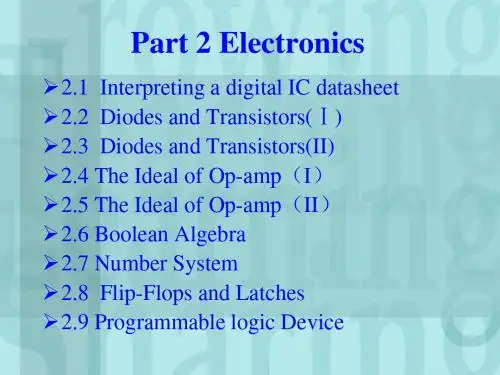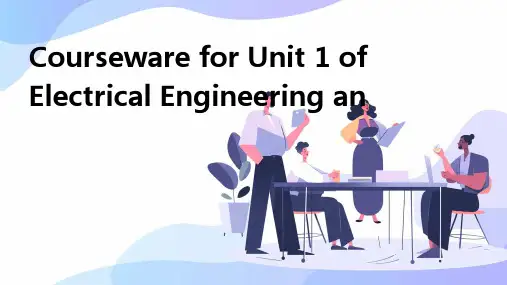自动化专业英语.pptx
- 格式:pptx
- 大小:492.28 KB
- 文档页数:128
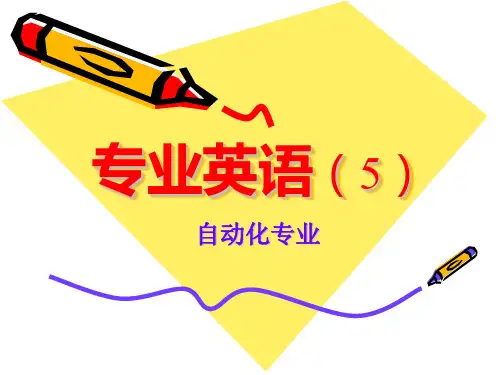

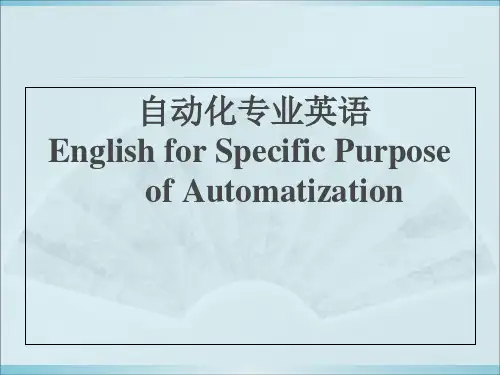
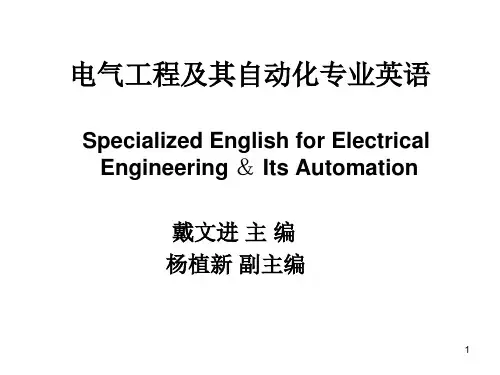
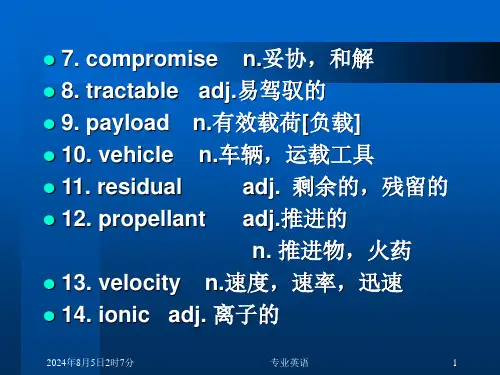


Lesson 1 Introduction toControl SystemPartΙIntroductionAutomatic control has played a vital role in the advancement of engineering and science. In addition to its extreme importance in space-vehicle, missile-guidance, and aircraft-piloting systems, etc, automatic control has become an important and integral part of modern manufacturing and industrial processes. For example, automatic control is essential in such industrial operations as controlling pressure, temperature, humidity, viscosity, and flow in the process industries; tooling, handling, and assembling mechanical parts in the manufacturing industries, among many others.Since advances in the theory and practice of automatic control provide means for attaining optimal performance of dynamic systems, improve the quality and lower the cost of production, expand the production rate, relieve the drudgery of many routine, repetitive manual operations etc, most engineers and scientists must now have a good understanding of this field.The first signific ant work in automatic control was James Watt’s centrifugal governor for the speed control of a steam engine in the eighteenth century. Other significant works in the early stages of development of control theory were due to Minorsky, Hazen, and Nyquist, among many others. In 1922 Minorsky worked on automatic controllers for steering ships and showed how stability could be determined by the differential equations describing the system. In 1934 Hazen, who introduced the term “servomechanisms” for position con trol systems, discussed design of relay servomechanisms capable of closely following a changing input.During the decade of the 1940’s, frequency-response methods made it possible for engineers to design linear feedback control systems that satisfied performance requirements. From the end of the 1940’s to early 1950’s, the root-locus method in control system design was fully developed.The frequency-response and the root-locus methods, which are the core of classical theory, lead to systems that are stable and satisfy a set of more or less arbitrary performance requirements. Such systems are, in general, not optimal in any meaningful sense. Since the late 1950’s, the emphasis on control design problems has been shifted from the design of one of many systems that can work to the design of one optimal system in some meaningful sense.As modern plants with many inputs and outputs become more and more complex, the description of a modern control system requires a large number of equations. Classical control theory, which deals only with single-input-single-output (SISO) systems, becomes entirelypowerless for multiple-input-multiple-output systems (MIMO). Since about 1960, modern control theory has been developed to cope with the increased complexity of modern plants and the stringent requirements on accuracy, weight, and industrial applications.Because of the readily available electronic analog, digital, and hybrid computers for use in complex computations, the use of computers in the design of control systems and the use of on-line computers in the operation of control systems are now becoming common practice.The most recent developments in modern control theory may be said to be in the direction of the optimal control of both deterministic and stochastic systems as well as the adaptive and learning control of complex systems. Applications of modern control theory to such nonengineering fields as biology, economics, medicine, and sociology are now under way, and interesting and significant results can be expected in the near future.PartⅡTerminology Used in Control SystemNext we shall introduce the terminology necessary to describe control systems.Plants. A plant is a piece of equipment, perhaps just a set of machine parts functioning together, the purpose of which is to perform a particular operation. Here we shall call any physical object to be controlled (such as a heating furnace, a chemical reactor, or a spacecraft) a plant.Systems. A system is a combination of components that act together and perform a certain objective. A system is not limited to abstract, dynamic phenomena such as those encountered in economics. The word “system” should, therefore, be interpreted to imply physical, biological, economic, etc., system.Disturbances. A disturbance is a signal which tends to adversely affect the value of the output of a system. If a disturbance is generated within the system, it is called internal, while an external disturbance is generated outside the system and is an input.Feedback control. Feedback control is an operation which, in the presence of disturbances, tends to reduce the difference between the output of a system and the reference input (or an arbitrarily varied, desired state) and which does so on the basis of this difference. Here, only unpredictable disturbance (i.e., those unknown beforehand) are designated for as such, since with predictable or known disturbances, it is always possible to include compensation with the system so that measurements are unnecessary.Feedback control systems. A feedback control system is one which tends to maintain a prescribed relationship between the output and the reference input by comparing these and using the difference as a means of control.Note that feedback control systems are not limited to the field of engineering but can be found in various nonengineering fields such as economics and biology. For example, the human organism, in one aspect, is analogous to an intricate chemical plant with an enormous variety of unit operations. The process control of this transport and chemical-reaction network involves a variety of control loops. In fact, human organism is an extremely complex feedback control system.Servomechanisms. A servomechanism is a feedback control system in which the output is some mechanical position, velocity, or acceleration. Therefore, the terms servomechanism and position- (or velocity- or acceleration-) control system are synonymous. Servomechanisms are extensively used in modern industry. For example, the completely automatic operation of machine tools, together with programmed instruction, may be accomplished by use of servomechanisms.Automatic regulating systems. An automatic regulating system is a feedback control system in which the reference input or the desired output is either constant or slowly varying with time and in which the primary task is to maintain the actual output at the desired value in the presence of disturbances.A home heating system in which a thermostat is the controller is an example of an automatic regulating system. In this system, the thermostat setting (the desired temperature) is compared with the actual room temperature. A change in the desired room temperature is a disturbance in this system. The objective is to maintain the desired room temperature despite changes in outdoor temperature. There are many other examples of automatic regulating systems, some of which are the automatic control of pressure and of electric quantities such as voltage, current and frequency.Process control systems. An automatic regulating system in which the output is a variable such as temperature, pressure, flow, liquid level, or pH is called a process control system. Process control is widely applied in industry. Programmed controls such as the temperature control of heating furnaces in which the furnace temperature is controlled according to a preset program are often used in such systems. For example, a preset program may be such that the furnace temperature is raised to a given temperature in a given time interval and then lowered to another given temperature in some other given time interval. In such program control the set point is varied according to the preset time schedule. The controller then functions to maintain the furnace temperature close to the varying set point. It should be noted that most process control systems include servomechanisms as an integral part.Part ⅢNew Words and PhrasesNew Words:1. analogous[ə'næləgəs]adj. 类似的,相似的2. drudgery['drʌdʒəri] n. 苦差事,苦工3. differential [difə'renʃəl]adj. [数学] 微分的n. [数学] 微分4. deterministic[di,tə:mi'nistik]adj. 可定的,明确的,决定性的,确定性的5. designate['dezigneit]vt.指明,指出,任命,指派6. function['fʌŋkʃən]n. 官能,功能,职责,仪式;函数vi. (器官等) 活动,运行,行使职责7. humidity [hju:'miditi]n. 湿气,潮湿,湿度8. hybrid['haibrid] computer 混[复]合计算机9. integral ['intigrəl]adj. [数学]积分的n. [数学] 整数,积分10. intricate['intrikit]adj. 复杂的,错综的,难以理解的11. interval['intəvəl]n. 间隔,距离,幕间休息12. optimal ['ɔptəməl]adj. 最佳的,最优的,最理想的13. plant[plɑ:nt]n.工厂,对象,车间,设备,联合装置14. preset[pri:'set]vt.事先调整,预先安置,预先调试15. relieve [ri'li:v]vt.减轻,解除,援救,救济,换班16. routine [ru:'ti:n]n. 例行公事,常规,惯例,日常事务,程序adj. 常规的,平淡的,乏味的17. relay [ri'lei]n.继电器18. stringent ['strindʒənt]adj. 严厉的,迫切的19. stochastic[stə'kæstik]adj. 随机的,机遇的,偶然的,推测的20. servomechanism ['sə:vəu'mekənizəm] n. 伺服机构(系统),自动控制装置,跟踪器21. synonymous[si'nɔniməs]adj. 同义的22. terminology[,tə:mi'nɔlədʒi]n. 术语学,术语,专门名词23. thermostat['θə:məstæt]n. 自动调温器,温度调节装置24. tooling['tu:liŋ]n. 用刀具加工,工具,机床安装25. unpredictable['ʌnpri'diktəbl]adj. 不可预知的26. viscosity[vis'kɔsiti]n. 黏质,黏性27. velocity [vi'lɔsiti]. n. 速度,速率Phrases:1. adaptive and learning control (自)适应与学习控制2. centrifugal [sen'trifjugəl] governor 离心调速器3. common practice 常规,习惯作法,一般惯例4. liquid['likwid]level 液位5. machine tools 机床6. under way 在进行中,在行进,起步的,启动的常用拉丁缩写:1. i.e. [,ai'i:]abbr. [拉] id est [id’est]=that is (to say) 也,即,就是2. etc abbr. [拉] et cetera:[ètsétɚrə] 等等Part ⅣExercises1. Translate the following into English.电流常数偏差流量根轨迹参考输入控制回路设定值过程控制最优控制反馈控制自动调节系统古典控制理论现代控制理论内扰外扰准确性稳定性频率响应时域响应2.Translate the following into ChineseIn many cases, the design of control system is based on some theory rather than intuition or trail-and-error. Control theory is used for dealing with the dynamic response of a system to commands, regulations, or disturbances. The application of control theory has essentially two phases: dynamic analysis and control system design. The analysis phase is concerned with determination of the response of a plant (the controlled object) to commands, disturbance, and changes in the plant parameters. If the dynamic response is satisfactory, there need be no second phase. If the response is unsatisfactory, a design phase is necessary to select the control elements (the controller) needed to improve the dynamic performance to acceptable levels.。
